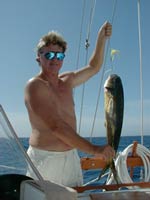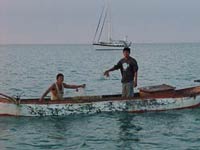|
14 October 2000 Cabo de Vela, Colombia 12*12.27N, 072*10.69W
We didn't leave "The
Rock" that night either, and the boys didn't get us any grouper.
While there were a few fish down there, there were dozens of LARGE
barracuda, shadowing us like street gangs, which definitely dampens
the enthusiasm for hunting, especially with no dinghy along to put
the catch in.
We did in fact leave
at 0230 Friday the 13th. Now does that bespeak secure people? There
were four boats that left in staggered departure times according
to their self-perceived speeds. It was the full moon, so it was
a spectacular night. The winds were actually a little light for
us, and from dead astern, so we had to tack downwind, somewhat of
a pain with the whisker pole, but the seas state was down, which
was one of our big objectives.
 We
reached the northern Colombian coast around sunrise. After the waters
of Bonaire, Curacao and Aruba, where one is out of sounding range
within a few hundred feet of the coast, it was strange to have a
bottom beneath us again (50-100') The north coast appears to be
a desolate stretch of near desert conditions with tall mountains
way off in the distance. When we finally rounded the corner of the
peninsula at Punta Gallinas around noon, the wind picked up, boatspeed
picked up to 7-8 kts! and the fishing line sung into action. We
caught four fish, two good-sized spanish mackerel, the world smallest
dorado (mahi) and another small one who shook himself free. One
of our buddies caught a 25 lb blackfin tuna! Damn! Our favorite! We
reached the northern Colombian coast around sunrise. After the waters
of Bonaire, Curacao and Aruba, where one is out of sounding range
within a few hundred feet of the coast, it was strange to have a
bottom beneath us again (50-100') The north coast appears to be
a desolate stretch of near desert conditions with tall mountains
way off in the distance. When we finally rounded the corner of the
peninsula at Punta Gallinas around noon, the wind picked up, boatspeed
picked up to 7-8 kts! and the fishing line sung into action. We
caught four fish, two good-sized spanish mackerel, the world smallest
dorado (mahi) and another small one who shook himself free. One
of our buddies caught a 25 lb blackfin tuna! Damn! Our favorite!
There is very little
development along this coast until you come to Bahia de Portete
which we understand is a coal-loading operation. Outside the Bahia
we came upon a designated ship anchorage where we sailed right through
five huge transports, an eerie feeling!
Cabo de Vela was an impressive
headland. There was a rock that was essentially a glossy black pyramid
rising from buff-colored bluffs, almost impossible to capture on
film. The seas got steeper and the winds steadily increased along
a couple of miles of cliff. We had steadily furled the genoa smaller
and smaller down to a quarter of its whole actually trying to reduce
our speeds, before we finally rounded into a cove through a huge
school of yellow, globular jellyfish, and there is nothing quite
like bringing the bow into a roaring wind after a long downwind
trip. Wow!
All four boats arrived
within an hour or so of each other. At first the cove did not seem
hospitable, the hillside a harshburnt umber with littlevegetationand
a stark lighthouse. But the sunset was gorgeous, the moonrise even
more so, our fresh fish supper yummy, and gradually the winds lightened.
By morning the place seemed positively gentle. Through the night,
several motorized canoes (with one-lunger engines; they don't sneak
up on you) of fisherman set nets among us. During coffee, two of
the boat stopped by to offer us fish or lobster, but we were stymied
by no idea on either side of the exchange rate between Colombia
pesos and UD dolares. Really we needed no fish, but the attempt
to chat with the fishermen seemed to be enjoyable for all. Even
my pequeno bit of espanol gets us somewhere!
Our weather window is
superb, and the moon still full, so all four of us will move out
this afternoon for the 120-mile, overnight leg to Bahia Cinto, a
series of five picturesque bays just north of Santa Marta, a real
town! From there it will take us a half day plus two more full days
to reach Cartagena, so we may linger awhile at this next stop. After
all, although we are eager to have this journey done with, we are
NOT hyper to get back to an urban setting.
|